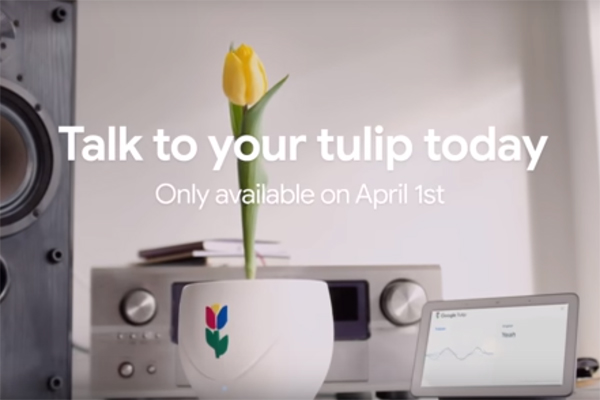Google Assistant Introduces Google Tulip Allowing Users to Talk to Plants
Today Google announced that Google Assistant on the Google Home Hub has the ability to talk to plants, in particular, tulips, “due to great advancements in artificial intelligence.” Google Tulip was largely developed in the Netherlands, a country that produces 12.5 billion flowers a year, which is around 50% of all flowers in the world. The country’s most famous flower is the Tulip. Google and the Wageningen University & Research team were able to build on Assistant’s existing Neural Machine Translation in order to map tulip signals to human language. After two years of training, Tulipish has been added as a language to Google Home’s interpreter mode, meaning Google Assistant now offers translation between Tulipish and dozens of human languages. The feature was tested in the Netherland’s world-famous flower park, Keukenhof. Users can say,
Okay Google, talk to my Tulip.
Google Duplex is Nothing Compared to Google Tulip
In order to develop this technology, Google began looking at how plants communicated with one another through their root systems. The demonstration video shows tulips listening to users talk about their day, and of course requesting lots of water and sun. Voicebot’s Bret Kinsella also commented on the new feature,
Some people were surprised by Google Duplex: An AI assistant that can make phone calls for you and spare you the hassle of human interaction. Google Tulip takes the capability to an entirely different species that can benefit from AI in ways that surpass mere convenience. It is the only way these plants can communicate with their human cultivators and admirers. Google often talks about the next billion connected humans. What no one saw coming was the first billion connected flowers. This changes everything. Google Tulip is a great example of how the company has a broad vision of how applied innovation can help more than just humans.
Tulipish is just the beginning, too. Google researchers describe Tulipish as a rudimentary language for understanding nature and point out that the more we listen to nature, the more we discover the amazing things it has to say. Updates involving communication with other kinds of plants, like cacti, are already underway. The feature is only available today, April 1st, 2019, for use by the general public. So, you better give it a try now before it’s gone.
Steven Arkonovich Creator of Big Sky on Alexa – Voicebot Podcast Ep 90









